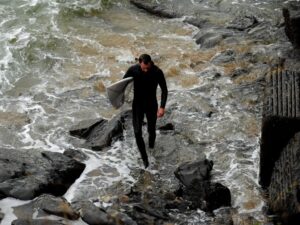Surfing, with its exhilarating blend of adrenaline, skill, and connection with the ocean, has captured the hearts of water enthusiasts worldwide. As a beginner surfer in the United States, it’s easy to get bummed out seeing riders effortlessly gliding along the water’s surface.
But don’t worry. It’s part of the learning curve everyone has to go through. Whether you’re a novice surfer craving the rush of catching your first wave or an intermediate rider eager to add new tricks, I have compiled a list of the top 6 surfing tricks for beginners to master.
Let’s hype you up first. Picture this: the sun-kissed shores of California, the vibrant waves of Hawaii, or the breathtaking coastlines of Florida.
Imagine yourself standing on your board, feeling the ocean’s energy beneath your feet, and then propelling yourself forward as you harness the power of the wave.
It’s a moment of pure exhilaration, and it’s within your reach. Let’s get started!
1. Bottom Turn

This one is a classic, simple, yet one of the smoothest tricks in surfing. A bottom turn is exactly what the name says it is, a maneuver where the surfer makes a turn at the bottom of the wave.
Bottom turns are a fundamental technique you must learn to be efficient while surfing. This trick allows you to use the energy you gain as you descend the wave to make sharp, crucial horizontal turns.
Tips for mastering bottom turns:
- Time your turn before the wave flattens.
A helpful rule of thumb while going for bottom turns is executing the turn before hitting the flat bottom. You must direct your momentum in time to maintain the power to turn.
- Dig the rail
To make the turn, you must dig the rail facing the wave. This leads to the water thrusting upon the opposite rail and giving you the energy needed to make the turn. A common mistake in this step is digging the rail too little or, sometimes, too much.
I suggest learning front-hand bottom turns if you are just starting. For obvious reasons, front-hand bottom turns are generally considered easier than backhand bottom turns.
It’s natural to have more control over your body in the direction you are looking at, which is quite the opposite in the case of a backhand bottom turn.
Common Mistakes
Beginners tend to judge the waves wrong and end up making their descent from a part of the face that doesn’t provide them with enough energy for the maneuver. This is a skill you must work on mastering.
2. Reentry
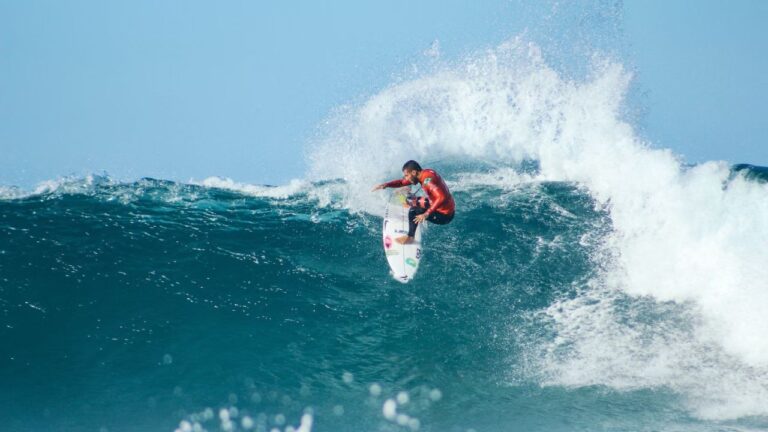
Reentry is an exciting surfing trick that you can learn as a beginner. It’s cool to look at as well as thrilling to pull off. It is often referred to as a vertical turn or a lip bash.
This trick involves charging your surfboard off the breaking section of the wave and smoothly landing back on the wave face. The first step is a basic bottom turn, followed by rotating upto the lip and turning back.
Tips to Master Reentry
- Master the basics first.
Before attempting the re-entry, make sure you’re strong at the basics, such as the bottom above the turn. Look for a section of the wave that’s steep and about to break—where you’ll start.
- Do not dig the nose
Gain speed and power by using your arms and legs to pump your board as you approach the lip. With all that adrenaline flowing in, you might lose track and end up digging your board’s nose, beware.
Similar to a bottom turn, the backside variation of the re-entry is considerably tougher to pull off compared to the front side one.
3. Popping up
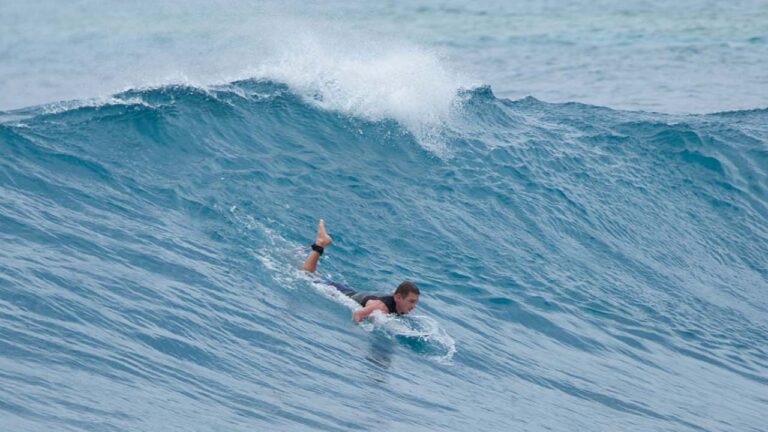
Popping up is an essential skill in surfing where the surfer “pops up” from lying to standing. It’s the act of taking control. Popping up is often overlooked by beginners due to its simplicity. You might know how to pop up, but do you know how to do it properly?
Professional surfers have absolute mastery over their popping-up technique. The smoother the transition, the better the control as you skip through the hurdles of adjusting yourself once you’re up.
Tips for mastering Popping up
- Harness the wave’s momentum.
There is no proper way to pop up. Whichever technique allows you to be smooth and makes things easier for you is the way to go. As a rule of thumb, you want to use the momentum of the water to throw yourself up. The lower body pressures the tail while you push your upper half up.
- Practice makes perfect
Once you figure out your technique, it’s time to master landing on your feet and maintaining balance, which also happens to be the part that you will fine-tune and perfect over your months and possibly years of surfing.
Common Mistakes
- Looking in the direction you wish to be your trajectory is much more helpful than looking down aimlessly at your feet.
- Timing mistakes are the most common among beginners.
- Grabbing the rail for extra balance might be tempting, but it’s as counterproductive as it gets. You might end up losing all your balance.
4. Duck Dive
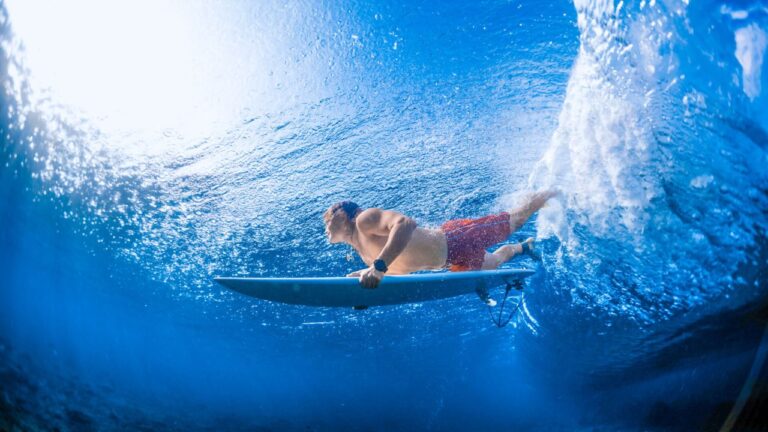
A duck dive is a trick where the surfer dives under a wave and resurfaces to “dodge” it. Duck diving falls under the intermediate difficulty territory. To properly execute this technique, you must have good control and a decent idea of how waves work.
Board size and Turtle Rolls
The duck diving technique requires you to work against the buoyancy of the surfboard. A shorter board can make things easier from the get-go. If you’re more of a longboard enthusiast, try turtle rolls!
Tips to Master Duck Dives
- Dip the nose
So how do we do it? Unlike most other tricks, the first step in a duck dive is quite intuitive. Once you’re no more than a couple meters away from the wave, you must dip your board’s nose to ensure it cuts through the striking wave. Push down until the board is completely submerged.
- Make use of buoyancy.
You want to minimize the water hitting the bottom of your board straight-on. Otherwise, chances are, you will be thrown backward. The rest is aligning your body upwards and letting the buoyant forces push you up.
5. Pumping
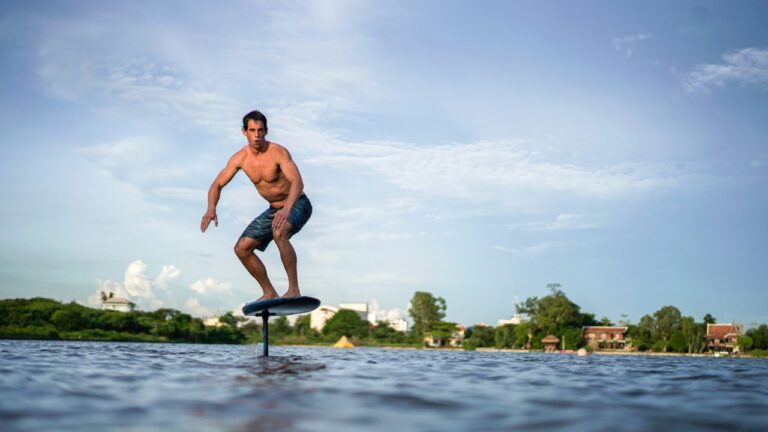
The pumping technique is similar to what it sounds. It involves adjusting your body weight distribution over the board and utilizing it to gain speed.
Pumping is one of the basics of surfing; just like popping up, you must master pumping to be more efficient and gain complete control over your maneuvers.
Tips for mastering Pumping
- Compression
Adjusting your weight can come down to two simple moves: compression and decompression. Compression is the surfer trying to maximize the pressure on the board, pushing it down.
- Decompression
Decompression, on the other hand, signifies the exact opposite. It’s letting go of all the weight and trying to be light, typically while rising over a wave.
- Be quick
These two moves of compression and decompression are to be performed quickly and be timed accurately to pull off the pumping trick successfully.
6. Cutback
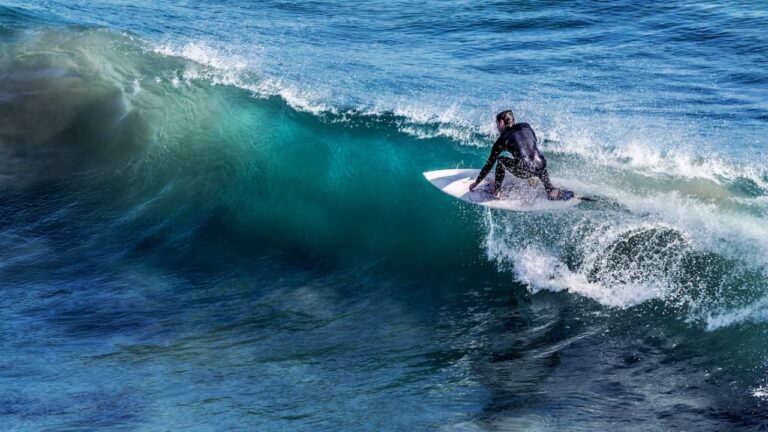
A cutback is yet another intermediate-level move, but I would advise trying it out early if you wish to have the upper hand at this technique.
“Cutback” involves changing your direction and aligning yourself in a way that lands you right in the face of the wave. This results in an unusual gain in momentum that allows you to continue riding the wave.
Tips for mastering Cutback
- Master Top turns
Learning the cutback should not be a problem if you have mastered top turns since it’s based on most of the same basic principles one requires for a top turn. The only difference is the “turn” is pulled off for a longer duration, resulting in a complete maneuver that pushes you back onto the breaking part of the wave.
- Align your arms correctly.
Slowly steering, aligning your arms in the direction you wish to move helps make completing the cutback much smoother.
The cutback technique, just like a bottom turn, has two variations. The front-hand variation is easier than the backside variation.
Common Mistakes
While performing a cutback, just like in a pop-up, not looking at the direction you wish to move in sets you back and makes things harder. Maintaining balance before and after the turn tends to be hard for beginners since there is little time to think, and the wave rushing toward you is quite intimidating.
Safety Considerations
These tricks must seem exciting to our rookie readers, but amongst this thrill, remember that prioritizing safety should always be at the forefront of your mind. Before you
try out these tricks. Here are some things to keep in mind.
1. Master the basics
Building a solid foundation by learning the basics before attempting these tricks. Mastering the fundamentals of surfing is simply paramount. Make sure you are a good swimmer before you start, besides learning these basic techniques:
- Paddling
- Catching Waves
- Popping up
- Maintaining Balance
- Wave Reading
Remember not to rush through the learning process and take things at your own pace.
2. Choose the right surf spot
Opt for a surf spot with smaller and mellow waves suitable for beginners. Avoid spots with large, powerful waves that can be overwhelming and dangerous for practicing tricks. Look for gentle, rolling waves that allow for easier maneuverability.
Surf spots with sandy bottoms or soft breaks offer a safer environment for beginners. These types of breaks minimize the risk of injury when attempting tricks and provide a forgiving landing surface.
3. Don’t surf alone
Considering all kinds of risks involved with surfing, it is always better to surf with a buddy or other people nearby. Surfing with a friend is not only more enjoyable but also significantly safer.
And if you have a friend who’s more experienced in surfing, you can get valuable on-the-spot feedback on your techniques and postures.
Having someone nearby who can provide immediate assistance in an emergency can sometimes be a lifesaver. This also means that you should always look for other surfers enjoying the waters at the same location. Remember, safety is a collective responsibility.
4. Do your research well
Seek advice from experienced surfers or local instructors who can provide insights into suitable surf spots for beginners. They can offer valuable information about specific breaks, currents, and any hazards to be aware of.
Weather affects every surfing session; check the local weather before you get your board and get to the beach. Sometimes it’s nice not to mess with the weather anomalies and let mother nature calm down.



